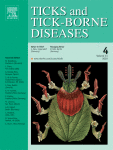Ver ítem
- xmlui.general.dspace_homeCentros Regionales y EEAsCentro Regional Santa FeEEA RafaelaArtículos científicosxmlui.ArtifactBrowser.ItemViewer.trail
- Inicio
- Centros Regionales y EEAs
- Centro Regional Santa Fe
- EEA Rafaela
- Artículos científicos
- Ver ítem
Successive treatments with ivermectin (3.15%) to control the tick Rhipicephalus (Boophilus) microplus in cattle: Pharmacokinetic and efficacy assessment
Resumen
This study aimed to evaluate the pharmacokinetics, the potential accumulation in the body of treated animals and the efficacy of ivermectin long-acting formulation (3.15%) against the cattle tick Rhipicephalus (Boophilus) microplus in a scheme of three successive treatments. Fifteen 12-month-old heifers, naturally infested with R. microplus, were divided into two groups (G). Cattle from GI (n = 10) were subjected to three treatments with ivermectin 3.15%
[ver mas...]
This study aimed to evaluate the pharmacokinetics, the potential accumulation in the body of treated animals and the efficacy of ivermectin long-acting formulation (3.15%) against the cattle tick Rhipicephalus (Boophilus) microplus in a scheme of three successive treatments. Fifteen 12-month-old heifers, naturally infested with R. microplus, were divided into two groups (G). Cattle from GI (n = 10) were subjected to three treatments with ivermectin 3.15% (IVOMEC GOLD®, Merial Argentina S.A.) at a rate of 1 mL/50 kg on days 0, 35, and 70. Cattle from GII (n = 5) were not treated. From day 1 to 202 post-treatment blood samples were taken to measure ivermectin concentrations by HPLC and female ticks (4.5–8 mm) were counted to evaluate the efficacy of the treatment. The level of tick resistance to ivermectin was evaluated before and after finishing the scheme of successive treatments by larval immersion test (LIT) bioassay from engorged females collected from GI. The area under the concentration vs. time curves (AUC0–35d) obtained post-second treatment was 1.51 ± 0.39-fold higher than those observed post-first treatment (P<0.05). The mean plasma concentrations of ivermectin 3.15% at 20 days after the first, second and third treatment were 17.0, 27.5 and 37.8 ng/mL, respectively (P<0.01). The elimination half-life of ivermectin post-third treatment was significantly longer than that was previously reported after a single dose (P<0.01). Values of therapeutic efficacy percentage reached 75.6% post-first treatment and between 95.9 and 100% after the second treatment. Ticks evaluated by LIT showed a significant increase in lethal concentrations after treatments. Although the efficacy level was high, the successive treatments with long-acting ivermectin formulation generate a significant accumulation of drug in plasma and could increase the levels of resistance to this drug in the tick population.
[Cerrar]

Autor
Sarli, Macarena;
Miró, Maria Victoria;
Rossner, Maria Victoria;
Nava, Santiago;
Lifschitz, Adrian Luis;
Fuente
Ticks and Tick-borne Diseases 13 (1) : 101848 (January 2022)
Fecha
2022-01
Editorial
Elsevier
ISSN
1877-959X
Documentos Relacionados
Formato
pdf
Tipo de documento
artículo
Proyectos
(ver más)
INTA/2019-PE-E5-I109-001/2019-PE-E5-I109-001/AR./Convocatoria: Estudios para el control de enfermedades subtropicales y/o transmitidas por vectores (Tristeza Bovina, Garrapatas, Miasis, Tripanosomiasis, Lengua Azul y la
Palabras Claves
Derechos de acceso
Restringido
 Excepto donde se diga explicitamente, este item se publica bajo la siguiente descripción: Creative Commons Attribution-NonCommercial-ShareAlike 2.5 Unported (CC BY-NC-SA 2.5)
Excepto donde se diga explicitamente, este item se publica bajo la siguiente descripción: Creative Commons Attribution-NonCommercial-ShareAlike 2.5 Unported (CC BY-NC-SA 2.5)

